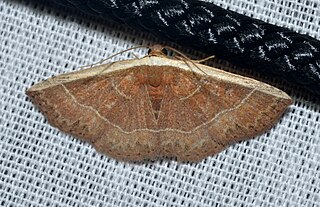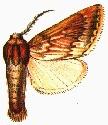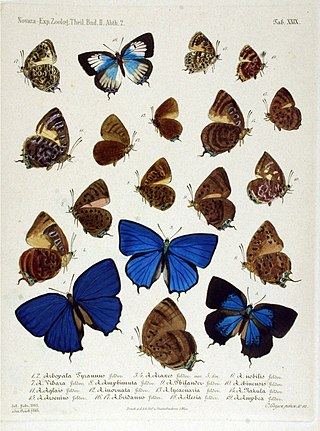
Hypena is a genus of moths in the family Erebidae. It was first described by Franz von Paula Schrank in 1802. These non-migratory moths overwinter as pupae and almost never estivate as adults.
Ctenosia is a genus of moths in the subfamily Arctiinae. The genus was erected by George Hampson in 1900.
Chusaris is a genus of moths of the family Erebidae. It was erected by Francis Walker in 1859.

Corgatha is a genus of moths of the family Erebidae erected by Francis Walker in 1859.

Hypenagonia is a genus of moths of the family Erebidae first described by George Hampson in 1893. The adult moths have pale brown wings with a dark band across each wing. The wingspan of these moths is about 1 centimeter.

Hyperstrotia is a genus of moths of the family Erebidae. The genus was erected by George Hampson in 1910.

Oruza is a genus of moths of the family Erebidae erected by Francis Walker in 1862.
Rhynchina is a genus of moths of the family Erebidae, that was formerly placed in the Noctuidae. The genus was erected by Achille Guenée in 1854.

Rivula is a genus of moths in the family Erebidae described by Achille Guenée in 1845.

Sesamia is a genus of moths of the family Noctuidae erected by Achille Guenée in 1852. Most but not all of its species are Afrotropical in distribution, with a preference for humid, open habitats. Larvae are stemborers, and several species of Sesamia are known agricultural pests on cereals, such as Sesamia calamistis, the African pink stemborer, and Sesamia inferens, the Asiatic pink stemborer.

Hydrelia is a genus of moths in the family Geometridae first described by Jacob Hübner in 1825.
Xenonola is a monotypic moth genus of the family Nolidae described by Wileman and West in 1928. Its only species, Xenonola limbata, was first described by Wileman in 1915. It is found in Taiwan.
Asura punctilineata is a moth of the family Erebidae first described by Alfred Ernest Wileman and Richard South in 1919. It is found on Luzon, in the Philippines.
Ctenosia albiceps is a moth of the subfamily Arctiinae. It was described by George Hampson in 1901. It is found on the Bacan Islands in Indonesia.
Ctenosia infuscata is a moth of the subfamily Arctiinae. It was described by Oswald Bertram Lower in 1902. It is found in Australia.

Episcepsis inornata is a moth of the family Erebidae. It was described by Francis Walker in 1856. It lives in Central America. It has also been seen in southern Texas.
Tampea hammatocera is a moth of the subfamily Arctiinae first described by Wileman and West in 1928. It is found on Luzon in the Philippines.

Amphitorna purpureofascia is a moth in the family Drepanidae. It was described by Wileman in 1911. It is found in Taiwan and China (Hainan).
Mesopsestis is a monotypic moth genus belonging to the subfamily Thyatirinae of the Drepanidae and was described by Shōnen Matsumura in 1921. Its single species, Mesopsestis undosa, was described by Wileman in 1911. It is found in Japan.

Arhopala inornata is a butterfly in the family Lycaenidae. It was described by Cajetan Felder and Rudolf Felder in 1860. It is found in the Indomalayan realm.









